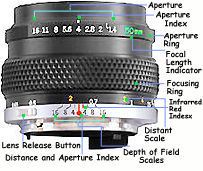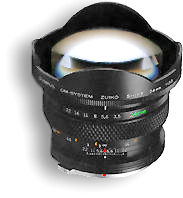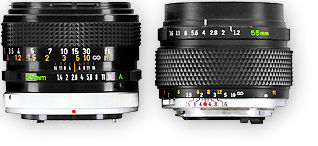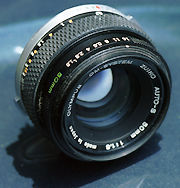There are two principle reasons why 35mm single lense reflex cameras are said to be lense-based. First, they take pictures "as you see them." This doesn't mean the subject as you see it with your naked eye, but as you perceive the image presented by the lense. Second, look through the viewfinder of an SLR camera and you'll see that the area you focused on looks sharp while all other areas appear blurred.
 |
Thus all modern SLR viewfinder systems have made it possible to make visual checks through the viewfinder of the actual optical changes caused by the lense in use. |
Etymology of "Zuiko"
The Olympus Optical Company was established in 1919 under the name of "Takachiho" - mythical mountain ruled by the Goddess of Sun which may be compared to Greece's Mount Olympus. In 1936, it began the production of camera lenses and selected the name of "ZUIKO", meaning "blissful light". Since then, ZUIKO lenses have been widely acclaimed throughout the world.
Alphabetical Coding:
Each ZUIKO Lens is described with an alphabetical prefix and suffix such as F . ZUlK0 AUTO-S, AUTO-T, etc. The prefix represents the number of elements in a lens in alphabetical order. For an instance, "A"=1 element, "B"=2 elements, "D"=4 elements, and so forth. "AUTO" signifies automatic diaphragm. The suffix represents the type of lense: "S": Standard, "W"=Wide Angle and "T"=Telephoto.
Olympus ZUIKO lense Group
Shown below
is how an SLR viewing system works. Light passing through the lense from the subject
strikes a 45° inclined mirror housed in the body. The mirror reflects the image
to the focusing screen. Reflected in turn by the pentaprism, the image you see by
looking through the finder is correctly oriented and right side up. When you push
the shutter button the mirror swings up and out of the way allowing the light to
go directly to the film to form a latent image of the subject. You see the actual
image in the viewfinder in the whole process until the instant the mirror flips up.
In practice, you will see the subject as it is recorded on the film in most shooting
conditions.
 |
 |
 |
 |
| Viewing, metering through the lense (TTL) | Mirror flip-up, lense
diaphragm stopped down, light reaching the film and thus, an exposure is formed |
Shutter curtain closes, reflex mirror stays down, back to TTL viewing | |
One reason
for the development of the SLR (and possibly the biggest reason contributing to its
immense popularity) is the lack of of parallax error associated with rangefinder-type
cameras. Because the viewfinder is separate from the lense in a rangefinder camera,
the view in the viewfinder, especially in close focusing, can be radically different
from the lense' image.
Known as parallax, the result is a marked difference between the viewfinder image
and the image actually recorded on the film. With SLR cameras, however, this will
not happen. For all practical purposes you record on film what you see in the finder.
This feature of the SLR becomes particularly significant when the subject fills the
viewfinder screen to the edges. This ability to record on film virtually all that
you see in the finder is particularly important for close-up or macrophotography.
With SLR cameras, extreme close-ups that would be impossible with the rangefinder
system are easy. In many ways, on the other extreme, super telephotography presents
another advantage where it is difficult to matched by a conventional rangefinder
system, especially in focusing accuracy.
|
|
In short, rangefinder camera needs an external focusing accessory finder to 'simulate" views of extreme short focal length (usually 21mm and below). It also requires an external view finder for lenses above 90mm to improve focusing accuracy. A single lense reflex camera can freely uses lense of any focal length or types and you will be still viewing an image true to its nature through the lense. |
Basically, due to the nature
of the SLR viewing and operating concept and system, focusing is extremely accurate
no matter which lense is mounted on the camera, wide angle or telephoto. The distance
from the camera's mirror to the focusing screen is the same as the distance from
the mirror to the film plane. Focus is precise with any lense from extreme wide-angle
to super telephoto or zoom lense. If you focus the image sharply on the viewing screen
it will be sharp on film. The advantage of SLR in terms of convenience, precision
in focusing and its adaptability to varying focal length and angle of view is indeed
very hard to rival by the rangefinder system. While some may argue that rangefinder
cameras has a far brighter viewfinder image than a SLR, but its overall restrictions
has hindered its progress for further development to become a mainstream camera system.
Well, that is only forming the basis. The wide range of lense selection is another
major factor contributing to the success of SLR photography The medium has never
been so fun and assuring with greater yield of successful photography with the additional
aid of other camera technologies.
|
|
lenses were made wider and at the same time, having further of reach on the longer focal length. From circular to full frame Fisheyes lenses, ultra-wideangle lenses that can even have your feet included in its viewpoint to super telephoto lenses of 2000mm either in true telephoto or reflex (Mirror) lense or modern high performance zoom lenses, it is not too un common for any moderately sized 35mm SLR photographic system to equip with at least 30-40 choices on different lense types. |
While number may be misleading at times, quality is the ultimate criterion of any camera, especially an SLR system camera. In this respect the OM System is quite outstanding, if not comparable to other major players such as Nikon, Canon, Contax, Pentax, Leica or the Minolta. Olympus is also one of the longest serving manual focus SLR camera manufacturers and does not seemed too interested in the autofocus arena and rather put all their research effort on the SLR instead. Up to the nineties, the OM lense group has mushroomed to more than 50 odd interchangeable lenses; many of which are offering first rated performance in an astonishingly compact, lightweight format, just as their famed OM bodies because OM lense system was developed along with the cameras themselves, based on exactly the same concept of functionality. But to make the performance of true practical value, it emphasized quick operation, easy lense changing, and compactness for easy carrying too.
As with OM bodies, Zuiko lenses do have a lot of common unique product characteristics. Other than compactness, rugged and extremely well made; its positioning of controls is equally different from lenses of other makes.
 |
The Aperture Ring on the Zuiko lense is designed in a equally unfamiliar external ring position, which is very similar to those medium format lenses like those Zeiss T* lenses for the Hasselblad or other large format lenses. Depite this, when Olympus decided to introduced their first ever programmed AE camera, the "ESP"* capable OM40 (OM PC) back in in 1984. (OM-2SP was NOT Olympus's first, it was, in fact introduced AFTER the OM4 which brought us multi-spots metering capability), the Zuiko lenses can even provide Programmed AE without any form of physical modifications. |
In relation to selective lensee types, some of the Zuiko optics can truly claimed to be world class performer and packed with practical yet useful features such as fast lense speed, careful choice of focal length selection and innovative in their design. Further, OM lense design targets called for resolution and sharpness equal to those of the finest rivals, great reductions in size and weight withouit compromised oin built quality and ruggedness, minimal of optical aberration, extra-close focusing while maintaning high image quality, and in many cases offer at least a version that comes with unprecedented brightness. Optical excellence means employing the right type of optical glasses, multi coating techniques, the right choice of durable material for lense construction etc.to enble Zuiko lenses stand up to the expectation of the most demanding photographers. In terms of innovation, the original Zuiko 50mm macro lense was the world's first to adopt automatic close range optical correction system to extend high optical performance to close focus range.
 |
Any serious photographer's eyebrows will be raised when you mention optics such as the high speed Zuiko 21mm f/2.0; Zuiko 100mm f/2.0 ED, Zuiko 180mm f/2.0 ED IF, Zuiko 250mm f/2.0 ED IF and Zuiko 350mm f/2.8 EDIF. Other more specilaised lenses like the Zuiko 24mm f/3.5 PC (Perspective Control) which still holds the distinction as being the widest lense type among all lense makers until today (Finally equalled by Canon EOS's EF TS-E 24mm f/3.5 L after 20 years in existence). The Macro lense group and the extensive OM macro system was another area where OM lenses really triumph and undisputedly has the most comprehensive among any 35mm SLR system - there are a total of seven automatic macro lenses and more than 4 are bellow types which will extends magnification ratio to beyond 10 X ! |
 |
An older G-Zuiko* 55mm f/1.2 lense is even slightly smaller than a comparing Canon FD 50mm f1.4 SSC with Breech Lock mount. |
 |
 |
* G-Zuiko means there are 7 elements in its optical composition. (E=5, F=6, G=7, H=8, I=9; J=10, K=11). Some Zuikos show "AUTO-S" denoting the lense as a Standard, while AUTO-W and AUTO-T refer to Wideangle and Telephoto construction. All newer series of Zuiko dropped such classifications. |
Of late, I have only observed the Zuiko 35mm-80mm f/2.8 ED that came in as a bundle lense for the OM3Ti which I thought was immensely overpriced. But the most worrying aspect is not related to lenses, but rather the commitment of Olympus into the further development of Zuiko lenses for OM SLRs. Perhaps, high sales and profit from other commanding fields such as the popular P&S models and of late, has stalled further development of their SLR lines of cameras. But in generally, that is NOT a proprietary problem for Olympus, but rather the direction of the whole industry is heading. It is a sad state, but all you can do now is to make full use of the your selection from the 50 odd lenses which should be more than sufficient to covers all aspect of general photography.
 |
Overall, I would like to put less emphasis on whether OM Zuiko lenses are the best in the world or how they measure against competitors such as Leitz , Zeiss or Nikkors nor to affect one's buying decision, but rather how the selection will supplement a photographer to be more productive and creative in the process. Secondly, just let me inspire you with this: together with the Pentaxes, OM cameras and Zuiko lenses combination is the best performer in terms of price/performance ratio among all other 35mm system. Anyway, that is not the subject matter of this site, rather - the right choices and options available to supplement an OM user. I will leave it to the Message Board to let other users debate or discuss on the earlier topic. |
Some of the useful reference
sites on the Net relating to OM Zuiko lenses:
1) Paul Farrar maintains a useful Zuiko lense reference site which can be used as a buying
reference.
2) Download the current OM lense brochure (Adobe Acrobat 1.1Mb) from Olympus America.
A Brief
overview on Zuiko Optics
Zuiko Fisheye Lenses 8mm f/2.8 Circular Fisheye | 16mm
f/3.5
Full Frame Fisheye
Zuiko Ultra-Wideangle Lenses 18mm f/3.5 | 21mm f/2.0 | 21mm f/3.5 | 24mm f/2.0 | 24mm f/2.8
Zuiko Wideangle Lenses 28mm f/2.0 | 28mm f/2.8 | 28mm f/3.5 | 35mm f/2 | 35mm f/2.8 |
Zuiko Standard Lenses 40mm f/2.0 | 55mm f/1.2 | 50mm f/1.2 | 50mm f/1.4 | 50mm f/1.8 | Zuiko 50mm f/2.0 PF
Zuiko Medium-Telephoto Lenses 85mm f/2.0 | 100mm f/2.0 | 100mm f/2.8 | 135mm f/2.8 | 135mm f/3.5
Zuiko Telephoto Lenses 180mm f/2.0 EDIF | 180mm f/2.8 | 200mm f/4.0 | 200mm f/5.0 Auto-T (brief)
Zuiko Super-Telephoto Lenses 250mm f/2.0 EDIF | 300mm f/4.5 | 350mm f/2.8 EDIF | 400mm f/6.3 | 500mm | 600mm f/6.5 |1000mm f/11.0
Special application Zuiko optics: 24mm f/3.5 Shift | 35mm f/2.8 Shift | 500mm f/8 Reflex | AF Zoom 35-70mm
f/4.0
| Zuiko
50mm f/2.0 PF
Tele-Converters: 1.4X-A / 2X-A
Zuiko
Macro/Close focus lenses: Zuiko
AUTO MACRO 20mm f/3.5
| Zuiko
AUTO MACRO 20mm f/2.0
| Zuiko
AUTO MACRO 38mm f/3.5
| Zuiko
AUTO MACRO 38mm f/2.8
| Zuiko
AUTO MACRO 50mm f/3.5
| Zuiko
AUTO MACRO 50mm f/2.0
| Zuiko
AUTO MACRO 1:1 80mm f/4.0
| Zuiko
AUTO MACRO 90mm f/2.0
| Zuiko
AUTO MACRO 135mm f/4.5
Zuiko AUTO-Zoom Lenses
- Main
Index page
| S-Zuiko
AUTO Zoom 28-48mm f/4.0
|
Zuiko AUTO Zoom 35-70mm f/3.6
|
S-Zuiko AUTO Zoom 35-70mm f/4.0
|
Zuiko AF AUTO Zoom 35-70mm f/4.0
| S-Zuiko
AUTO Zoom 35-70mm f/3.5 ~ f/4.5
| S-Zuiko
AUTO Zoom 35-70mm f/3.5 ~ f/4.8
| Zuiko
AUTO Zoom 35-80mm f/2.8 ED
|
Zuiko AUTO Zoom 35-105mm f/3.5 ~ f/4.5
| Zuiko
AUTO zoom 50-250mm f/5.0
|
Zuiko AUTO zoom 65-200mm f/4.0
|
S-Zuiko AUTO zoom 70-210mm f/4.5 ~ f/5.6 | Zuiko AUTO Zoom 75-150mm f/4.0 | Zuiko AUTO Zoom
85-200mm
f/4.0
| Zuiko
AUTO Zoom 85-250mm f/5.0
| S-Zuiko
AUTO Zoom 100-200mm f/5.0
|
Olympus OM-2SP: Camera Operations | Other Issues
Specifications | Main Reference Map / nomenclature
| Back | Index Page of OM Zuiko lenses
| Back | to Main Index Page of OM1(n) & OM2(n)
Series SLRs
| Message Board | for
your favourite Olympus
OM-1(n)
and OM-2(n)
series models
| Message Board |
for your
Zuiko Optics in a shared environment
| Message Board | Specifically for Dispose or Looking for OM Photographic
Equipment
About this photographic site.
Home - Photography in Malaysia |
Copyright
© 2000.
leofoo ®. MIR Web Development Team.
Maintainers
for OM Zuiko Site & Message Board:
Rick
Oleson (Email: rick_oleson@yahoo.com Website:
http://rick_oleson.tripod.com), Bruce Hamm
(bhamm@magma.ca), John Orrell
(john@orrellj.freeserve.co.uk), Simon Evans,
(http://www.mawddwy.freeserve.co.uk); Shaun
(shaun@noemail.com), Andy Radcliffe
(AndyJRadcliffe@manx.net)
Special
thanks to:
Gregory
P. Logiodice, Bob Gries, Erwin Voogt, Joel Wilcox, Rick
Oleson, Simon Evan and many others for granting permissions to use their images
of either lenses, cameras and own pictures appeared in this Zuiko website.
Credit: My old time buddy,
Ahmad
Ikram,
Dr of Rubber Research Institute (RRI), Malaysia
who shares the same passion with me and also lending his OM-1n, OM-4 and the Motor
Drive 1 to me for preparing some images in this site; Mark Dapoz <md@dementia.org>for reminding
some broken links; Mr Poon of Foto Poon, Ipoh, Mr Richard, Ampang Park,
Mr Lim and Miss Jenny of Foto Edar for their generosity for
their OM1(n), OM2n camera and some Zuiko lenses. Mr Hans van Veluwen for
mistakenly using some content earlier from his OM website; J Sorensen
for providing some useful images to rectify some technical "flaws"; Mr
Gen Holst for helping during the early stages of development of this OM site;
Mr KKLow for some of his earlier images on the OM-1appeared in this website;
Miss Wati and Mirza for helping me
to convert this Operation Manual into a HTML format. Mr MCLau for rectifying
some mistakes made on the earlier preview sites. A personal tribute to the creator
of the OM system and also a site dedicated to all the fans of Olympuses and Zuiko
Optics worldwide. Some of the content and images appeared in this site were scanned
from OM official marketing leaflets, brochures and instruction manual(s) for educational
purposes. Olympus is a registered trade name of Olympus Optical Inc., Japan. Site
created 'unfortunately again with an IMac.

